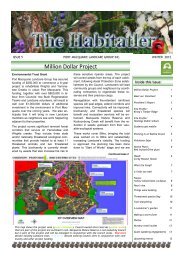Get the Latest information on fighting weeds - Port Macquarie ...
Get the Latest information on fighting weeds - Port Macquarie ...
Get the Latest information on fighting weeds - Port Macquarie ...
You also want an ePaper? Increase the reach of your titles
YUMPU automatically turns print PDFs into web optimized ePapers that Google loves.
Comm<strong>on</strong> name: Cot<strong>on</strong>easter Latin name: Cot<strong>on</strong>easter glaucophyllus<br />
FAMILY: ROSACEAE/MALACEAE<br />
ORIGIN:<br />
Noxious Weed Category: n/a<br />
Descripti<strong>on</strong><br />
Habit: Shrub to 4m, often multiple trunks arising from <str<strong>on</strong>g>the</str<strong>on</strong>g> base which take <strong>on</strong> an arching habit. The tree<br />
has a dull green appearance punctuated with clusters of bright red berries when in fruit. Leaves: Simple,<br />
alternate, discolourous (upper and lower surfaces distinctly different in colour), <str<strong>on</strong>g>the</str<strong>on</strong>g> lower surface with a<br />
wooly covering of hairs, leaves up to 10cm l<strong>on</strong>g. Flowers: In white clusters. Each flower about 8 mm wide,<br />
5-petalled. Flower stalk densely hairy. Flowers spring and summer. Fruit: A red berry to 10mm with multiple<br />
yellow seeds, presented in clusters.<br />
Ecology: Comm<strong>on</strong> ornamental. Widely naturalised <strong>on</strong> <str<strong>on</strong>g>the</str<strong>on</strong>g> fringes of urban bushland and roadsides near<br />
plantings. At least nine species of Cot<strong>on</strong>easter have naturalised in Australia. The fruit is palatable to<br />
animals, particularly birds and this helps <str<strong>on</strong>g>the</str<strong>on</strong>g> plant spread quickly over a wide range. It is aggressive in <str<strong>on</strong>g>the</str<strong>on</strong>g><br />
mid and understory of some forest types, although not well suited to <str<strong>on</strong>g>the</str<strong>on</strong>g> deep shade of rainforest. It invades<br />
heathland and heathy woodland, lowland grassland and grassy woodland, dry sclerophyll forest and<br />
woodland, damp sclerophyll forest, wet sclerophyll forest, riparian vegetati<strong>on</strong>, freshwater wetland<br />
(seas<strong>on</strong>al), and rock outcrop vegetati<strong>on</strong> (Carr et al 1992). It’s aggressive habit and ability to form dense<br />
thickets enables it to outcompete desirable vegetati<strong>on</strong>.<br />
Dispersal: Fruit are eaten and spread by birds, but also likely by terrestrial vertebrates such as rats. Seeds<br />
can be transported in flowing water of riparian systems. Also spread by humans as <str<strong>on</strong>g>the</str<strong>on</strong>g> plant is valued by<br />
some as an ornamental.<br />
C<strong>on</strong>trol:<br />
HAND: Cot<strong>on</strong>easter can be dug out, and seedlings and small plants hand pulled. CHEMICAL: Seedlings<br />
can be spot sprayed with glyphosate & water at 10mL L -1 + surfactant (eg Pulse or Rygel). The plant<br />
suckers readily so large plants can be treated by cut, scrape and paint stump, or stem inject with undiluted<br />
glyphosate.



